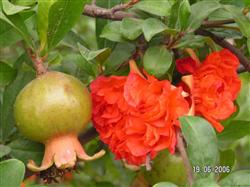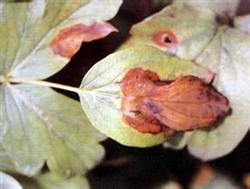Cutting Seedling technique of Peony Pomegranate

Peony pomegranate tree blossoms better than peony, peach and plum win fruit. The flowering period is as long as 5 months, the fruit is red and the grain is sweet. It integrates flower viewing, fruit viewing and eating, and is one of the rare tree species unique to our country. The preparation of cuttings should be collected from the annual branches of strong peony pomegranate trees with full maturity, full buds and high degree of Lignification. Before cutting root, cut the branch into 20 cm long branches (leaving 2-3 buds), cut the upper end flat at 2 cm above the bud, and cut the lower end at 1 cm below the bud, then soak it in clean water for 12 hours. Rooting treatment with abt rooting powder and other chemicals to root, the method is: first dissolve the agent with a small amount of alcohol, and then dilute the original solution to the required concentration and pour into the treatment container, the liquid surface depth is 2-3 cm, the cuttings after soaking in water are tied into small bundles, so that the cuttings base 3-5 cm upright immersed in the sink for 12 hours, can be taken out for use. The general use of ridge cutting, ridge width of 50 cm 60 cm, height 15 cm, ridge spacing 40 cm 50 cm, each ridge two rows, row spacing 25 cm 30 cm, plant spacing 10 cm 15 cm. From late March to early April, cuttings need to be cut with wood sticks and other cuttings, and then the cuttings treated by root are inserted to make the terminal buds exposed above the ground, pressed, and then irrigated with water in the furrows. After the water permeates, take the fluvo-aquic soil to cover the bud eye 1 cm thick to prevent the bud eye from being air-dried. Management after insertion should be often irrigated, but the amount of water should be less, and the soil should be loosened in time after watering. The seedlings can leave more branches instead of thinning branches, so that the crown can be expanded early. When the seedling is 20 centimeters high, nitrogen fertilizer is applied, usually 40 kilograms of ammonium sulfate per mu, followed by potash fertilizer. 0.3% urea was used in the early stage of foliar fertilizer spraying, and 0.3% potassium dihydrogen phosphate or soil was used in the later stage. For aphids and red spiders occurring in seedling stage, dichlorvos (800-1000 times) and ammonium parathion (1000-1200 times) can be sprayed on the leaves to control them in time.
- Prev

How to raise cyclamen potted plants? Breeding methods and key points of management and maintenance of cyclamen
Cyclamen alias radish and begonia, rabbit ear flower, rabbit flower, first crown, bonspark, petal lotus, is Primulaceae, cyclamen perennial herbs, is a kind of widely planted flowers, suitable for indoor flowerpots, winter needs to be planted in the greenhouse, the following editor will introduce the breeding methods of cyclamen
- Next

Control methods of Brown spot of Peony
Peony brown spot is a common disease in the later growth stage of peony. Symptoms: pale spots of different sizes appear on the leaf surface, usually round spots with a diameter of 3Mel and 7mm. There are 1-2 spots in a leaf, and up to 30 spots in a leaf. The middle of the spot gradually turns brown, and the front is scattered with very small black.
Related
- Fuxing push coffee new agricultural production and marketing class: lack of small-scale processing plants
- Jujube rice field leisure farm deep ploughing Yilan for five years to create a space for organic food and play
- Nongyu Farm-A trial of organic papaya for brave women with advanced technology
- Four points for attention in the prevention and control of diseases and insect pests of edible fungi
- How to add nutrient solution to Edible Fungi
- Is there any good way to control edible fungus mites?
- Open Inoculation Technology of Edible Fungi
- Is there any clever way to use fertilizer for edible fungus in winter?
- What agents are used to kill the pathogens of edible fungi in the mushroom shed?
- Rapid drying of Edible Fungi

